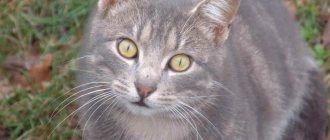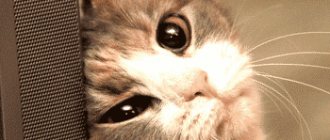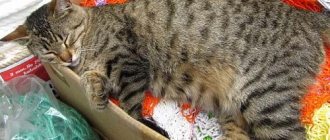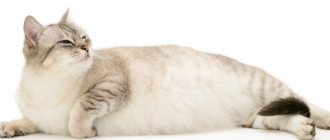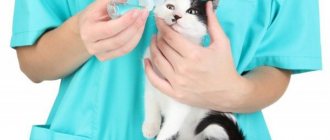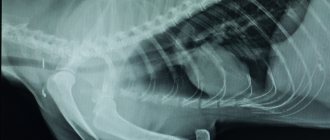When a cat is in an interesting position, the owner needs to show maximum attention and care. If there are deviations from the norm, it is important to notice them in time and take your pet for examination to a veterinarian. No person is born with the skills and knowledge of a doctor, so if you see unusual discharge from a cat, you should not treat the animal yourself. Blood discharge is considered especially dangerous for a pregnant purr.
Why does a pregnant cat have bleeding?
If there is a lot of discharge, it is difficult not to notice them - the substance remains fluffy on the tray, pieces of furniture and in your favorite sleeping place. When the volume of discharge is small, they may go unnoticed, then the owner should be alerted to the unusual behavior of the pet:
- frequent licking of the vagina;
- The fur on the tail is constantly damp or wet.
The discharge from a pregnant cat can suggest a number of causes and diseases:
- inflammation developing in the uterus;
- spontaneous abortion;
- too much mucus appears when a plug forms in the cervix;
- release of excess eggs;
- damage to the integrity of uterine tissue;
- placental abruption;
- death of unborn offspring.
Also pay attention to these warning signs:
- weakness;
- poor appetite;
- lethargy.
Some owners are perplexed - is it bad when a cat licks the vagina, she’s just clean. In fact, in this way, purring reduces the pain of the inflamed area, so blood is a serious reason to visit the doctor.
When and why bleeding may occur
Pregnant cat becomes sleepy
During pregnancy, your pet will be extremely calm. In particular, this will result in increased (and even excessive) drowsiness. But everything will change dramatically as a result of health problems. The cat will walk from side to side, gradually trying on the place previously chosen and prepared for it, and lick the loop.
As the birth of the first kitten approaches, severe pain will begin to appear, which can be noticed by rapid, heavy breathing. But your pet’s suffering can be much greater if you notice the presence of strange blood discharge.
Is bleeding dangerous?
Cat licks blood before giving birth
A safe option is a light red or slightly scarlet liquid that is about a tablespoon or less in volume. Such discharge lasts less than 10 minutes, which indicates that the cat is ready to give birth.
Any deviations from these parameters will be a cause for concern. If the color of the liquid is more reminiscent of bright red, dark scarlet and other rich shades, then you should start to worry: something is clearly wrong with your pet. Moreover, the color of the discharge can be green, brown, or yellow. Each of these signs in one way or another indicates problems with the fetus or the cat’s genitourinary system.
Blood clots
In addition, the presence of hair and blood clots in the discharge will be a bad sign. Unfavorable consequences for the health of the animal can occur if the liquid leaks out for too long, that is, more than 10 minutes.
You should also be wary of large volumes of blood loss: a volume exceeding one tablespoon is an extremely undesirable option. The cause of such manifestations, in addition to the problems mentioned above, can be diseases of the cat during pregnancy, as well as various injuries that it received immediately before giving birth or a couple of days before it.
How do cats develop pregnancy?
The entire period of gestation for furry kittens involves 9 weeks, they are divided into 3 trimesters. The most measured period is the middle one, it lasts from 3 to 6 weeks. At this time, the purr sleeps a lot, purrs, caresses, and according to an ultrasound examination, you can see how the offspring in the mother’s belly makes the first movements.
- Conception - 3rd week - eggs descend into the uterus, the fertilization of the fertilized egg occurs along with light pink discharge. At 2-3 weeks, the cervix closes with a plug consisting of dense mucus, the excess volume of which comes out of the vagina, mainly during urination.
- 3-6 weeks – a healthy cat does not suffer from discharge. But sometimes a transparent yellowish mass forms. This stage coincides with the appearance of noticeable roundness in the tummy. The expanding uterus is filled with amniotic fluid.
- 9th week – the pregnant woman’s body prepares for childbirth. The first discharge just before birth occurs one day before active labor.
How to care for a cat after giving birth?
The postpartum period for a cat begins from the moment the last kitten is born. This is quite a difficult time for the animal. A lot of resources are spent on caring for kittens, feeding them, and restoring their own health. In the first days after giving birth, the cat usually sleeps a lot, gaining strength, and eats little, as it feeds on the afterbirth.
However, the animal requires a lot of fluid to produce milk. Access to fresh water must be constant. Despite the decrease in the cat's appetite, it should be fed often in small portions - 5-6 times a day. It is best to give liquid food - cereals, dairy products, broths with vegetables and fish. In addition, the pet should receive its usual food in small quantities. If you choose store-bought food, then it should be special food for postpartum cats, since they contain enough essential nutrients and vitamins for a weakened animal.
Place the bed of the mother and her children in a warm and quiet place where strangers do not look. Cover the bottom of the basket with a soft, smooth cloth to prevent kittens' claws from clinging to it. Change the litter daily, or better yet, several times a day. Bowls with water and food, place the tray next to the box so that everything you need is closer to the cat.
A healthy cat can take care of her kittens and clean herself. If this is the first litter or the animal is too weak, your help may be needed. For example, if you see that your pet is unable to eliminate postpartum discharge, wipe her genital area with a towel dipped in warm water.
What kind of discharge does a pregnant cat have?
Veterinarians, when establishing the cause of the appearance of blood in a cat’s stool and after she has urinated, focus on the color of the discharge, uniformity and gestational age of the patient:
- If blood appears before childbirth, this is a bad sign. Bleeding, the duration of which exceeds 10 minutes, and the amount of blood is more than 1 tablespoon, requires an immediate response from the owner - go to the clinic, the doctor’s task is to stop the bleeding, otherwise the furry one may die.
- If clear discharge bothers you during the first 3 weeks after conception, it’s okay - it’s a traffic jam that prevents the offspring from being born before the due time.
- A brown mass that comes out of the vagina of a pregnant cat in the middle of the pregnancy cycle indicates placental abruption. What to do? Take tests, undergo an ultrasound and try to maintain the pregnancy.
- Bad-smelling discharge, also colored green, indicates that the kitten has died inside its mother, decomposition processes have begun, the cat must be urgently taken to a veterinary hospital, otherwise the decay will lead to blood poisoning and death. Be prepared for major surgery and a long recovery period.
- The appearance of pus - the inflammatory process has affected the uterus or other organs of the genitourinary system, possibly leaving much to be desired in the condition of the kidneys.
Pink discharge that is not dangerous
Discharge in the first period of a pale pink color is most often associated with the release of unfertilized eggs to the outside.
If such bleeding does not intensify and does not have a foreign odor, then there is no need to worry.
In the second period, there should normally be no bleeding. During this period, babies are actively gaining growth, the uterus is expanding, and the animal’s tummy is noticeably rounded. If there is noticeable scarlet bleeding that lasts more than 10 minutes, you should immediately consult a doctor. Possible causes: uterine rupture, inflammation, miscarriage.
In the third period at the end of pregnancy, a small bloody discharge (blood volume maximum 1 tablespoon) can serve as a harbinger of the onset of labor.
Dirty yellow discharge during childbirth is usually not serious and is associated with the waste products of kittens in the womb.
Cats are very clean by nature, so if your pet feels good, is cheerful and cheerful, then she licks herself on her own and the owner does not have time to notice anything. The presence of sticky lumps of mucus around the animal's loop should alert you. This is a sign that the pet is unwell and needs urgent help from the owner.
Normally, the owner should not notice any discharge
How to prevent bleeding in a pregnant cat
In a pregnant cat, bleeding occurs only in the presence of an inflammatory process and serious illnesses. So that your furry one can bear healthy offspring without problems, do not neglect preventive measures:
- When planning to conceive a purring cat, consult your doctor about what vitamins the animal may need to maintain immune strength, and inquire about the nuances of a balanced diet during pregnancy.
- Treat the purr with care and avoid active games. After all, a cat can damage its tummy.
- Get your vaccinations ahead of time.
- Avoid drafts; the room temperature should be comfortable.
- Communicate with your furry often and watch for behavioral changes.
Discharge in a cat before birth: signs of normality and abnormalities
Many cat owners, even if they have at least some experience, are afraid of their pet giving birth. You can often hear that the process of giving birth to babies almost certainly must be accompanied by some complications and difficulties. Fortunately, this is far from the case, and it is rarely necessary to really help the animal. Other breeders are concerned about discharge before childbirth: they also believe that discharge from the external genitalia must necessarily indicate something unpleasant and deadly... Is this really so, is it necessary to immediately contact a veterinarian?
We recommend reading: How to Give Drontal Plus to Dogs
Prevention is the key to health!
Thus, not all prenatal discharge in cats is normal, and if any occurs, you should immediately contact your veterinarian.
Even with timely treatment, there is no guarantee of preserving the life of kittens (or even the cat itself), and therefore every effort must be made to avoid the development of this type of pathology:
- Remember that in healthy cats the development of birth pathologies is practically excluded. In general, carefully monitor her diet, choose only high-quality food, and bring her to the veterinarian for a preventive examination at least once a quarter.
- In the second half of pregnancy, try to isolate the cat in a room where there are no high pieces of furniture or sharp corners so that the pet cannot injure its enlarged belly.
- Be sure to get all vaccinations prescribed by your veterinarian, as they will reliably protect your cat from many infectious diseases.
- A pregnant cat should be protected from drafts, but at the same time make sure that she does not sleep near heating appliances. Sudden changes in temperature have a bad effect on the intrauterine development of fetuses.
- Make it a habit to carefully observe your cat’s behavior for at least ten minutes a day. The sooner you notice any deviations from the norm, the sooner you can help her.
Most importantly, remember that any discharge from a pregnant cat that appears no earlier than a couple of weeks before the “official” due date is potentially dangerous!
Of course, there are situations when they have a completely natural origin, but much more often their appearance is a consequence of severe pathological processes. Only an experienced veterinarian in a well-equipped clinic can save the life of a pet and her offspring.
Most importantly, remember that any discharge from a pregnant cat that appears no earlier than a couple of weeks before the “official” due date is potentially dangerous!
How to distinguish a false pregnancy from a real one
So how to distinguish a false pregnancy from a real one based on a set of mental signs? In general, this is not so easy to do; you need to pay attention to many small nuances:
A “false-positive” cat’s mood changes very often and completely unpredictably. At one moment she can be active and playful, and after a few minutes she begins to hiss and avoid people.
Some cats become overly affectionate, while others hiss and run away from their owner, even if they previously could not live without his constant attention.
If during a normal pregnancy the animal begins to look for a place to give birth a couple of days (a week) before the birth, then during a false pregnancy it does this constantly, which drives the owners into hysterics. A cat can rummage through closets all day long and for at least three weeks, “inspecting” the most remote corners of the house.
Again, “preliminary” postpartum behavior is extremely uncharacteristic of a normal pregnancy. But with pathology, a cat that does not have and never had kittens begins to carry socks, slippers, small boxes and other “garbage” in its teeth, which it perceives as kittens.
It happens that during a false pregnancy, a cat becomes incredibly noisy: she constantly yells, demanding attention, meows and “squeaks.” Sometimes animals seem to “go crazy”, they become violent and completely uncontrollable. This happens due to an abnormal surge of hormones, as well as when hormones appear in the bloodstream, the combination of which is normal or does not exist at all, or their concentration is much lower.
Discharge and other physiological signs of pathology
These signs are no longer subjective and are clearly visible to the naked eye:
There is mucous discharge from the vulva. And if during a normal pregnancy they are rare and not too regular, then during a false pregnancy, mucous discharge from the external genitalia is constantly observed.
The abdomen enlarges and sags. Again, with normal gestation of kittens, this sign does not develop immediately, while with a false pregnancy, the cat may already look as if it is about to give birth in the second week.
The cat's appetite first increases and then worsens. In a normal pregnancy, the opposite is true: in the first half of gestation, the cat eats worse, but then the appetite quickly increases.
A riot of hormones often leads to frequent gastrointestinal disorders.
In addition, this pathology is quite characterized by a chronic increase in general body temperature.
What do the mammary glands look like during a false pregnancy?
Note that the mammary glands of a “false-positive” pet look exactly the same as if she were actually pregnant:
- The nipples become noticeably enlarged and swollen.
- As we mentioned above, milk production begins.
We also note that not all cases develop all of the above symptoms. Their appearance/non-appearance depends both on the specific case of pathology and on the psychophysical state of the cat. In addition, some pets have an extremely difficult time experiencing the state of an imaginary pregnancy, sometimes it even comes to real mental “oddities”.
Other cats may perceive their condition as a minor inconvenience. Accordingly, in the latter case, the likelihood of severe consequences is much lower, and there are much fewer reasons to visit the veterinarian.
Causes of pathological discharge
As a rule, in veterinary practice the following causes of pathological, unnatural discharge during the prenatal period are encountered:
- Any inflammatory processes localized in the uterine cavity.
- If there is a threat of miscarriage.
- It happens that to form a mucus plug, the body used too large volumes of a binder, which is why “leaks” of yellow (or brown) mucus can be observed throughout pregnancy. Hypothetically, such a phenomenon in itself does not pose a danger. Unfortunately, excessive “fluidity” of the mucus plug can lead to its complete, premature destruction. We have already talked about what this entails above.
- Quite rarely, but there are cases when, due to severe hormonal disorders, a pregnant cat develops signs of sexual heat, accompanied, among other things, by the release of eggs. At the slightest sign of this, you should immediately contact a veterinarian, since any hormonal disorders that appear during pregnancy (even in its final stages) are fraught with miscarriages, as well as the birth of weak and defective kittens.
- Ruptures of uterine tissue.
- Pathologies of the placenta, including cases of its detachment.
- Intrauterine death of kittens. Often even the most inexperienced breeder can find out about this, since the death of fruits is often accompanied by putrefactive decomposition (maceration). The smell and appearance of the discharge are appropriate; in severe cases, even being near a pregnant cat can be extremely difficult. Thick, white or green purulent discharge may appear.
We recommend reading: Small Ringworms From Cats on the Face
Pathological discharge in pregnant cats is often accompanied by other alarming signs: apathy, lack of appetite, inappropriate behavior . Note that negative symptoms also include the cat’s reluctance to lick the area of the external genitalia in the presence of discharge from them. Since such behavior (craving for cleanliness) is inherent in cats at the genetic level, the absence of this trait indicates a very serious condition of the animal.
What kind of discharge should you call a veterinarian for?
Discharge of clear mucus in the first weeks of pregnancy is completely normal. At this time, a mucous plug is formed in the cervix, and the “technological surplus” from this process is released into the external environment.
Depending on the color, smell and consistency, as well as the time of appearance (immediately before birth or long before it), the discharge can be either physiological or pathological, indicating the need to urgently call a veterinarian.
To accurately determine the nature of the “leaks”, you need to pay attention to the following signs:
- Bloody or bloody discharge that appears a few days before the kittens are born is a bad sign. If more than a tablespoon of blood is released, and its volume continues to increase, we are clearly talking about intrauterine bleeding. At the slightest suspicion of this pathology, you must urgently contact a veterinary specialist.
- If around the middle of pregnancy your cat develops reddish-brown spotting , this is a very bad sign. Most likely, it indicates placental abruption and intrauterine death of all offspring (the probability of this is very high). With properly prescribed treatment and a certain amount of luck, there is a chance to save offspring. In more severe cases, a decision may be made to surgically remove the entire uterus and ovaries.
- The discharge is greenish in color with a disgusting smell, this is very bad. The appearance of such signs clearly indicates not only the intrauterine death of all offspring, but also the putrefactive processes occurring in the mother’s body. There is practically no chance of saving the kittens; with a high degree of probability it can be assumed that treatment will require surgical removal of the entire uterus. However, here everything depends on the intensity of putrefactive-necrotic processes.
- The appearance of greenish, greenish-white, yellowish discharge is a very alarming sign, as they indicate the development of purulent inflammation of the organs of the reproductive system.
cat has white uterine discharge during pregnancy
Pyometra in a cat is a purulent inflammation of the uterus. The disease usually occurs at the age of more than 5 years in unsterilized animals. The cause may be hormonal imbalance, sexually transmitted infection, or the use of hormonal drugs to suppress estrus. Also, pyometra in a cat can occur after a complicated birth, when the placenta is retained, or when dead unborn fetuses are found in the uterus.
To prevent pyometra in a cat, it is best to sterilize the cat as early as possible (from the age of 8 months). If the cat is for breeding or you want to get kittens from her for yourself, you should not give the cat hormonal drugs to suppress estrus, only herbal sedatives (Kot Bayun, Stop - stress).
A cat can go into heat monthly and the cat's behavior during this period can be very unpleasant and burdensome for the owner. In this case, sterilizing a cat is the best solution for the animal and its owner, because it is relatively easy to tolerate and does not have long-term consequences for the animal, unlike the use of drugs to suppress estrus.
During childbirth, it is necessary to ensure that the cat does not give birth for more than a day, there are no more than 3.5 hours between kittens, and there are no long-term inconclusive contractions.
Discharge from the loop. They may be bloody or cloudy white and foul-smelling. The cat may leave stains on the bedding and discharge may drip
If you notice any of these signs in your cat, you should consult a doctor. If the wall of the uterus is thin, it may rupture with pyometra and pus may enter the abdominal cavity. Then saving the cat will be much more difficult.
The diagnosis of pyometra is confirmed by ultrasound of the cat's uterus. Drug treatment for this disease is usually ineffective and even dangerous. The most effective and rational treatment is removal of the cat's uterus (ovariohysterectomy). If the animal is not old and
Source
